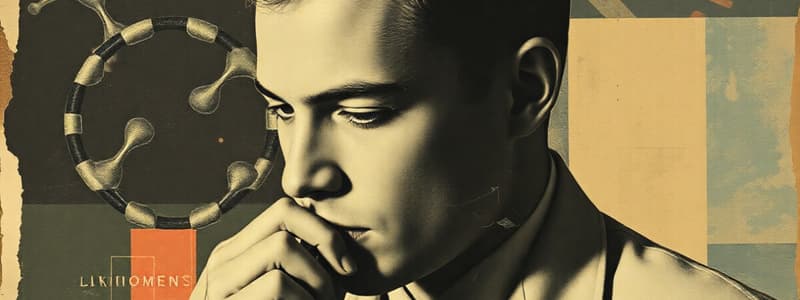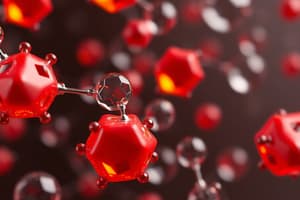Podcast
Questions and Answers
Which of the following is the primary mechanism by which androgens exert their effects on target cells?
Which of the following is the primary mechanism by which androgens exert their effects on target cells?
- Interacting with intracellular receptors to influence gene transcription. (correct)
- Directly modulating ion channel activity in the plasma membrane.
- Activation of G protein-coupled receptors on the cell surface.
- Inhibiting the activity of intracellular phosphodiesterases.
A researcher is investigating the effects of a novel androgen analog. Which cellular process would be most directly affected by this analog?
A researcher is investigating the effects of a novel androgen analog. Which cellular process would be most directly affected by this analog?
- Mitochondrial ATP production.
- Endoplasmic reticulum protein folding.
- DNA transcription in the nucleus. (correct)
- Ribosomal protein synthesis.
Which of the following is a primary action of androgens that contributes to the development of male secondary sexual characteristics?
Which of the following is a primary action of androgens that contributes to the development of male secondary sexual characteristics?
- Promotion of spermatogenesis in the seminiferous tubules. (correct)
- Induction of Leydig cell hyperplasia in the testes.
- Stimulation of estrogen synthesis in peripheral tissues.
- Inhibition of prolactin secretion from the pituitary gland.
A clinician is considering androgen therapy for a patient with muscle wasting due to AIDS. What is a potential benefit of androgen use in this context?
A clinician is considering androgen therapy for a patient with muscle wasting due to AIDS. What is a potential benefit of androgen use in this context?
Why are 17-alkylated androgens associated with a higher risk of liver toxicity compared to non-alkylated forms of testosterone?
Why are 17-alkylated androgens associated with a higher risk of liver toxicity compared to non-alkylated forms of testosterone?
How does Spironolactone's mechanism contribute to its anti-androgen effects?
How does Spironolactone's mechanism contribute to its anti-androgen effects?
A patient is prescribed finasteride for benign prostatic hyperplasia (BPH). What is the primary mechanism by which finasteride alleviates the symptoms of BPH?
A patient is prescribed finasteride for benign prostatic hyperplasia (BPH). What is the primary mechanism by which finasteride alleviates the symptoms of BPH?
A researcher is investigating the use of ketoconazole as an anti-androgen therapy. Which step in the steroidogenesis cascade is directly targeted by ketoconazole to reduce androgen production?
A researcher is investigating the use of ketoconazole as an anti-androgen therapy. Which step in the steroidogenesis cascade is directly targeted by ketoconazole to reduce androgen production?
A weightlifter is using anabolic steroids to increase muscle mass, which of the following cardiovascular changes is he most at risk of experiencing?
A weightlifter is using anabolic steroids to increase muscle mass, which of the following cardiovascular changes is he most at risk of experiencing?
In the treatment of precocious puberty ketoconazole is sometimes used off label. By what mechanism does it delay puberty?
In the treatment of precocious puberty ketoconazole is sometimes used off label. By what mechanism does it delay puberty?
A patient with advanced prostate cancer is being treated with both a GnRH agonist and an antiandrogen. What is the rationale for combining these two therapies?
A patient with advanced prostate cancer is being treated with both a GnRH agonist and an antiandrogen. What is the rationale for combining these two therapies?
An adolescent male is diagnosed with delayed puberty and is being considered for testosterone replacement therapy; what is the most important consideration?
An adolescent male is diagnosed with delayed puberty and is being considered for testosterone replacement therapy; what is the most important consideration?
A genetic study reveals that a male patient has a mutation resulting in a complete loss of function of the androgen receptor (AR) protein. What would be the expected effect of this mutation?
A genetic study reveals that a male patient has a mutation resulting in a complete loss of function of the androgen receptor (AR) protein. What would be the expected effect of this mutation?
Which of the following is the most direct mechanism by which anabolic steroids can lead to gynecomastia in male users?
Which of the following is the most direct mechanism by which anabolic steroids can lead to gynecomastia in male users?
Why is concurrent anticoagulant therapy a concern when prescribing androgens?
Why is concurrent anticoagulant therapy a concern when prescribing androgens?
What is the rationale behind administering testosterone via transdermal or intramuscular routes rather than orally?
What is the rationale behind administering testosterone via transdermal or intramuscular routes rather than orally?
How does dutasteride differ from finasteride in its mechanism of action and clinical applications?
How does dutasteride differ from finasteride in its mechanism of action and clinical applications?
A patient is diagnosed with hereditary angioedema. Which androgen derivative is most suitable in this scenario?
A patient is diagnosed with hereditary angioedema. Which androgen derivative is most suitable in this scenario?
What is the primary difference between steroidal and nonsteroidal antiandrogens, and how does this difference affect their clinical use?
What is the primary difference between steroidal and nonsteroidal antiandrogens, and how does this difference affect their clinical use?
Considering the actions of androgens, what potential adverse effect in women using testosterone therapy might be related to increased red blood cell production?
Considering the actions of androgens, what potential adverse effect in women using testosterone therapy might be related to increased red blood cell production?
Why are GnRH agonists sometimes used in conjunction with anti-androgens like flutamide in the treatment of prostate cancer?
Why are GnRH agonists sometimes used in conjunction with anti-androgens like flutamide in the treatment of prostate cancer?
A young male patient presents with gynecomastia, elevated liver enzymes, and decreased testicular size. He admits to using anabolic steroids. What is the most likely mechanism causing the gynecomastia?
A young male patient presents with gynecomastia, elevated liver enzymes, and decreased testicular size. He admits to using anabolic steroids. What is the most likely mechanism causing the gynecomastia?
How would you explain the mechanism through which androgens contribute to the acceleration of epiphyseal closure during puberty?
How would you explain the mechanism through which androgens contribute to the acceleration of epiphyseal closure during puberty?
A trans woman is undergoing hormone therapy. Why is spironolactone often part of her regimen?
A trans woman is undergoing hormone therapy. Why is spironolactone often part of her regimen?
Flashcards
Testosterone
Testosterone
The primary androgen, synthesized in Leydig cells under LH influence.
5α-reductase
5α-reductase
Enzymes that convert testosterone to 5α-dihydrotestosterone.
Synthetic androgens
Synthetic androgens
Synthetic androgens with modified structures, such as esters or alkyl groups.
Intracellular receptors
Intracellular receptors
Signup and view all the flashcards
Androgenic effects
Androgenic effects
Signup and view all the flashcards
Anabolic effects
Anabolic effects
Signup and view all the flashcards
Hypogonadism
Hypogonadism
Signup and view all the flashcards
Androgen adverse effects
Androgen adverse effects
Signup and view all the flashcards
Hepatic adverse effects
Hepatic adverse effects
Signup and view all the flashcards
Anti-androgens
Anti-androgens
Signup and view all the flashcards
Receptor Inhibitors
Receptor Inhibitors
Signup and view all the flashcards
Type II 5α-reductase
Type II 5α-reductase
Signup and view all the flashcards
Dutasteride
Dutasteride
Signup and view all the flashcards
Ketoconazole
Ketoconazole
Signup and view all the flashcards
Spironolactone
Spironolactone
Signup and view all the flashcards
Testosterone Synthesis Location
Testosterone Synthesis Location
Signup and view all the flashcards
5α-reductase function
5α-reductase function
Signup and view all the flashcards
Action of Androgen
Action of Androgen
Signup and view all the flashcards
Uses of Adrogens
Uses of Adrogens
Signup and view all the flashcards
Adverse effect – Androgens
Adverse effect – Androgens
Signup and view all the flashcards
Anti-androgens: Definition
Anti-androgens: Definition
Signup and view all the flashcards
Anti-androgens: Receptor inhibitors
Anti-androgens: Receptor inhibitors
Signup and view all the flashcards
Finasteride – Mechanism
Finasteride – Mechanism
Signup and view all the flashcards
Ketoconazole – Action
Ketoconazole – Action
Signup and view all the flashcards
Spironolactone – Mechanism
Spironolactone – Mechanism
Signup and view all the flashcards
Study Notes
Overview of Androgens and Related Pharmacology
- Androgens, synthetic androgens, actions, uses, adverse effects and antiandrogens.
Testosterone
- Synthesis occurs in the Leydig cells when stimulated by LH.
- It is metabolized into 5a-dihydrotestosterone by 5a-reductase
- 5a-reductase has two types: Type I is expressed in skin and liver, Type II in prostate, seminal vesicles and hair follicles.
- Administration can be done transdermally and intramuscularly.
Synthetic Androgens
- 17-substituted testosterone esters can be Testosterone propionate, testosterone enanthate, or testosterone cypionate.
- 17-alkyl testosterone derivates include Methyltestosterone, fluoxymesterone, oxymetholone, and can be administered sublingually.
- Nandrolone has a higher anabolic to androgenic ratio and is administered parentally.
- Oxandrolone is administered orally.
Androgen Actions
- Signal through intracellular receptors to control specific gene transcription.
- Control cell differentiation, development, and growth.
- Androgenic effects lead to differentiation and development of wolffian structures (epididymis, seminal vesicles, prostate, penis).
- Also have androgenic effects development and maintenance of male secondary sexual characteristics.
- Anabolic effects include acceleration of epiphyseal closure, linear growth at puberty, increase in muscle mass, and a positive nitrogen balance.
- Can cause aggressiveness and increased libido.
Androgen Uses
- Used for prepubertal and postpubertal hypogonadism, addressing linear growth, sexual maturation, male secondary sexual characteristics, libido, and potency.
- Addresses anemia by stimulating erythropoietin secretion, now largely replaced by recombinant erythropoietin.
- Can manage estrogen-dependent breast cancers.
- Can be used for wasting disorders.
- Treats severe burns.
- Addresses hereditary angioedema through androgen-dependent increases in C1 complement inhibitor.
- Part of menopausal hormone therapy, especially when estrogens are not effective.
Illicit Androgen Use
- Anabolic androgens are used by athletes.
- They are used to enhance the extent and rate of muscle formation.
- They are used to increase training intensity.
- Their adverse effects make their use inadvisable.
Androgen Adverse Effects
- Decrease testicular function.
- Can cause edema.
- Cause altered plasma lipids (increased LDL, decreased HDL).
- Cause masculinization in women.
- Increases plasma fibrinolytic activity which can cause severe bleeding with concomitant anticoagulant therapy.
- 17-alkyl substituted androgens can cause increased hepatic enzymes, hyperbilirubinemia, cholestatic hepatitis, and liver tumors.
- They are contraindicated in pregnant women, patients with hepatic or prostate cancer, and renal or cardiovascular disease.
Anti-Androgens
- Block the action or synthesis of endogenous androgens.
Anti-Androgens – Receptor Inhibitors
- Flutamide is a steroidal oral antiandrogen and a competitive androgen receptor antagonist.
- Nilutamide and bicalutamide are nonsteroidal androgen receptor antagonists.
- These are used as treatment for prostate cancer.
- They can be combined with GnRH agonist therapy.
Antiandrogens – Receptor Inhibitors Adverse Effects
- They can cause gynecomastia, elevation in liver enzymes, chest pain, GI disturbances, and can act as teratogenic agents.
Finasteride
- Inhibits type II 5a-reductase.
- Reduces 5a-dihydrotestosterone production.
- Treats benign prostatic hypertrophy and male pattern baldness.
- Decreases prostate volume and increases urine flow.
Dutasteride
- Inhibits both Type I and II 5a-reductase, making it more potent than finasteride.
- Treats benign prostatic hyperthrophy and baldness.
Ketoconazole
- Antifungal agent, this blocks multiple p450 dependent steps in the steroidogenesis cascade, including desmolase.
- Treats precocious puberty and hirsutism.
Spironolactone
- Prevents androgens and aldosterone from binding to their receptors.
- Decreases 17-hydroxylase activity.
- Treats hirsutism in women.
Studying That Suits You
Use AI to generate personalized quizzes and flashcards to suit your learning preferences.




